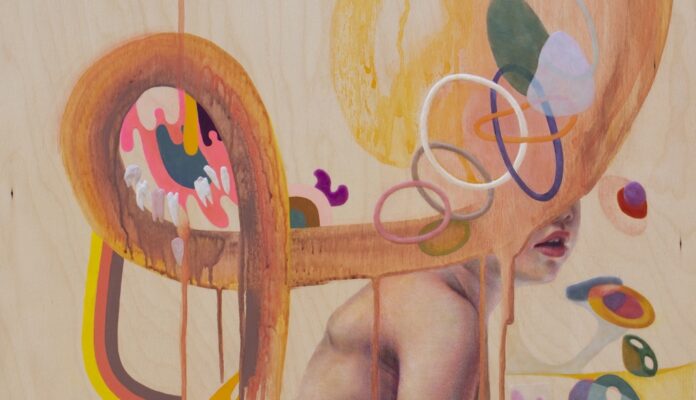“A black, E white, I red, U green, O blue: vowels,
I shall tell, one day, of your mysterious origins.”
Arthur Rimbaud, the author of A Season in Hell, opens his 1871 poem “Voyelles” with a pairing of vowels and colors. Regardless of whether the enfant terrible of French poetry was indeed, as some surmise, synesthetic, he succeeds in jolting language alive by subtly smuggling it into sensory neighborhoods of the mind from which it is traditionally barred. By making us sense language anew, Rimbaud injects it into the reader’s body, grafting it onto us like new skin. Artist JP Morrison Lans’ new show “The Love Eater” (through October 7 at Heron Arts), achieves a similar feat.
Morrison Lans deals with language, but her true raw material is the everyday. If Rimbaud injects color into achromatic language, Morrison Lans does so with the seemingly mundane. A three-hour dinner with her 6-year-old son evokes a Nietzschean conversation with the god of time (“Dinner with Aion”), a brick becomes the stage for our dual drives of creation and destruction to face off (“Pretty Brick”), and her son’s hands and husband’s foot become territories to explore the ineffability of what we are (“What Are You?”).
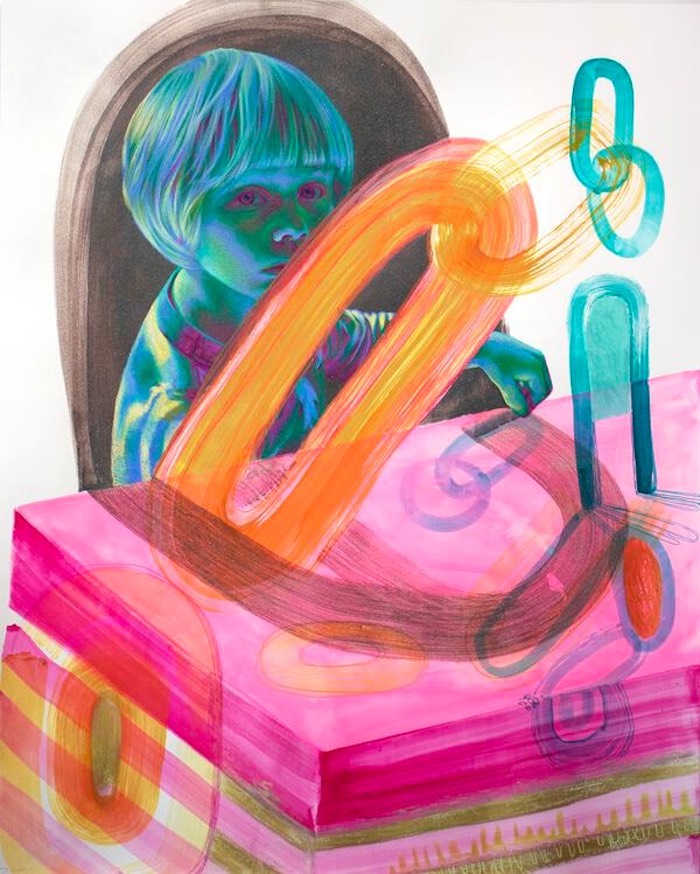
Morrison Lans’ work evokes the boldness of Baldessari’s colors, the poignant lyricism of Khalil Gibran’s figure drawing, and the magical indeterminacy of Hilma Af Klint’s abstraction. What is indisputably hers, however, is the diary-like nature of her work. As I absorbed each piece, I imagined her bent over a sketchbook, drawing to metabolize a recent lived experience, jotting down parallel existences as her parental obligations and artistic life blurred. The exhibition has the intimate beauty of a journal—one that reads the way a collection of short stories would, each work brimming with personal nuance and keen perception.
Walking into Heron Arts, the viewer is struck by the masterfully harmonious yet unhinged excess of color—radiant yellows, shy pinks, violent reds. Colors take central stage here—both the dramatis personae of her sensual play and the cast of her musical, enacting the epiphanies and surrenders, the slights and struggles many of us have lived through.
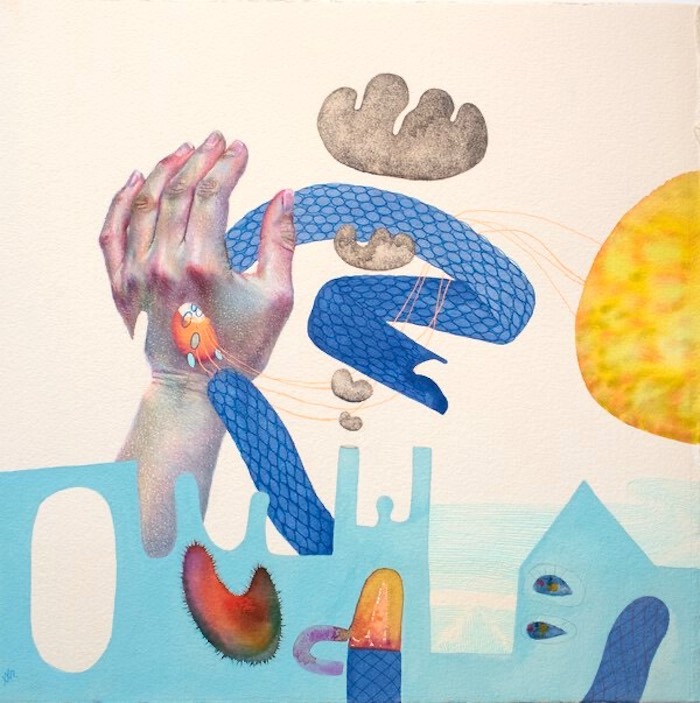
Morrison Lans marries those colors to figuration. When a swath of reptilian skin punctures a realistic hand in “The Indulgent Curve of Forgetting,” as coral-shaped gray clouds puff out of blue factory chimneys, or a pair of veined hands bore into a “Cobalt Cloud” sprouting a bacterial populace, reality is alchemized. Normalcies collide. Aberrations court new imaginaries. The delineation between delight and confusion dissolves, giving birth to a sensual experience more akin to urgent hunger—hence “The Love Eater”—than the usually detached experience of the gallery visitor.
As the line blurs, new concepts cross into consciousness, as if leaping through the blood-brain barrier. Emotions become prehensible, within physical reach. Describing “Cobalt Cloud,” the artist writes, cryptically: “oxytocin as an object.” The phrase imbues the prevalent hands with new meaning—twisting, reaching, grabbing as if they believed—actually believed—that emotions, concepts, or abstractions could be captured. What if touch could grasp the unfathomable, the stuff that labels fall short of explicating? What if contact could succeed where language fails?
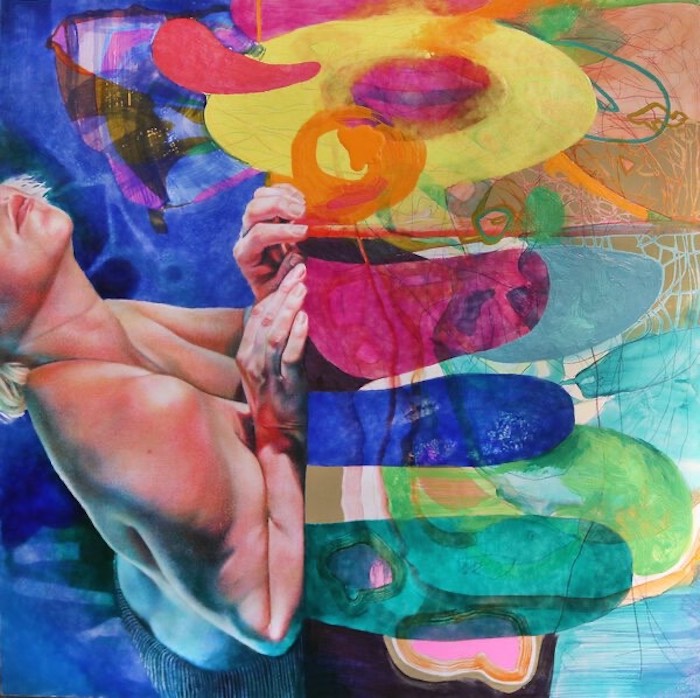
The artist is fully aware of the magic she is summoning. In the description of “Offerings of the Ego and the Animal,” Morrison Lans asks: “When we categorize artistic styles, what do realism and abstraction represent? Which one is the ego, and which is the animal? Which style is more ‘truthful’? Which one captures the true self, and which one is a personification? Are they at odds or the perfect unification of the internal and external worlds?” This captures the fluid tension in each of Morrison Lans’ pieces. Body parts and abstract shapes both fight for canvas space and co-create it.
“Knowledge is only a rumor until it lives in the muscle,” says the Papua New Guinea proverb. Both “The Drifting” and “The Magician”—more figurative pieces—illustrate this moment of liminal suspension. These chimeric pieces hang in the space between the carnal and what might one day become muscle. Before it does, there is a moment of gestation both physical and conceptual. It’s the moment before we fall into ourselves, the one before a choice takes shape within us.
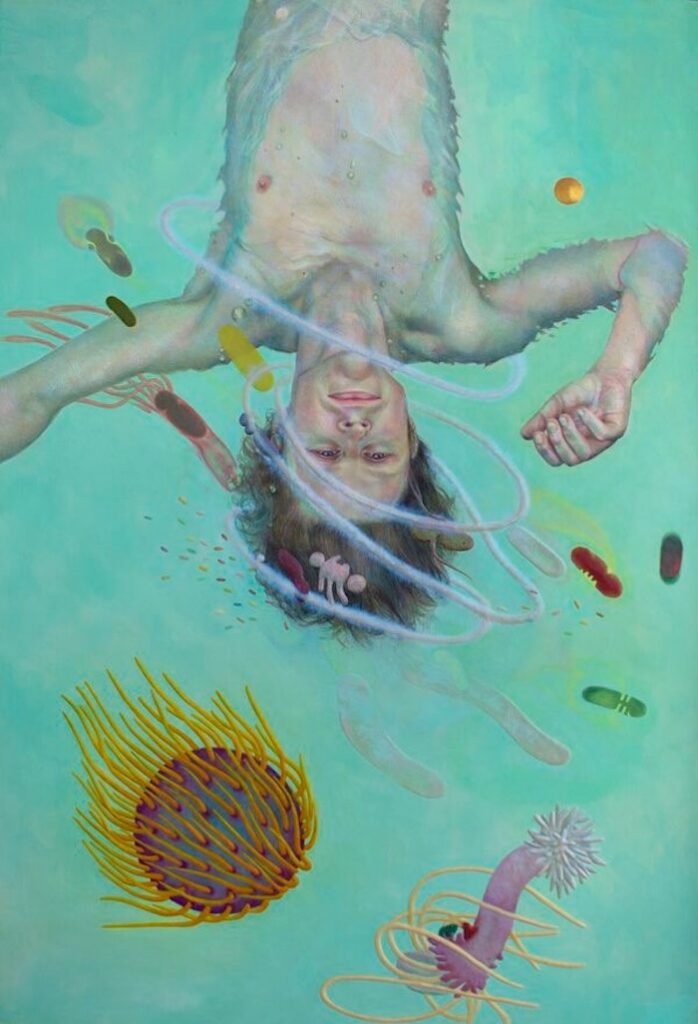
Lans borrows the magic of rhabdomancy (the explicit subject of one work), divination, and operating otoliths to convey this. Rhabdomancy is a divination technique that involves the use of any rod, wand, staff, or the like to find water underground, and, by extension, things invisible and unseen. One method was setting a number of staffs on end and observing where they fall, to divine the direction one should travel or to find answers to certain questions. Essentially, it’s an exercise in listening to how things fall. It’s a surrender to and a trusting in a rhythm other than our own.
Relatedly, in her description of “Upon Potential,” the painter acknowledges, “as hard as I plan, I am only a catalyst for an untamable outcome.” As an application of that epiphany, the artist co-paints “Was I Within You, Were You Within Me? Without Question” with her son. Morrison Lans’ work portrays a new form of surrender, an ecstatic experience that pays attention to the outgrowth of nature and the degradation of facades. She conducts a multi-perspectival approximation of reality, dancing through, falling into planes, snatching symbols, making talismans, eating love, birthing beauty on the way down.
JP MORRISON LANS: ‘THE LOVE EATER” through October 7 at Heron Arts, SF. More info here.


